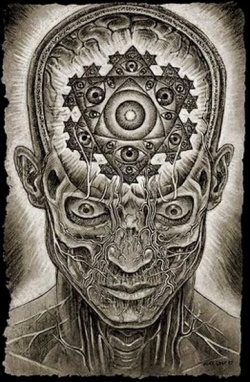Consciousness
Consciousness (Skt. vijñāna; Tib. རྣམ་ཤེས་, Wyl. rnam shes) is the fifth skandha.
It is divided into six or eight. consciousness: The six basic forms of consciousness are eye, ear, nose, tongue, body and mind consciousness.
There is also the “ego consciousness” or seventh consciousness and the “alaya vijnana” or “eight consciousness” as well as the” ninth consciousness” of the Absolute-void.
Both the eye and the visible object are the physical elements, therefore they are not enough to produce experience by themselves. Only the co-presence of consciousness together with the eye and the visible object produces experience.
Similarly, ear, nose, tongue and body are the same.
Consciousness is therefore an indispensable element in the product of experience.
Consciousness is mere awareness, or sensitivity to an object.
When the physical factors of experience, e.g. the eyes and visible objects come in contact, and when consciousness also becomes associated with the physical factors of experience, visual consciousness arises.
It is not just the personal experience.
The way that our personal experience is produced is through the functioning of the three major mental factors of experience, i.e. the aggregate of perception and mental formation. There are:
eye consciousness
ear consciousness
nose consciousness
tongue consciousness
body consciousness
mind consciousness
Note that there is the sixth sense, the mind. For the mind, the corresponding object is not a physical one, but are ideas - Dharma. The mind consciousness plays an important role in all mental activities.
Firstly, the first five consciousness are not related to each other, mind consciousness is their co-ordinator, establishing an entire meaningful idea or impression for a living being. Mind consciousness is the ability to recognize and discriminate in three ways:
Physical cognition - in the presence of physical objects, mind consciousness can recognize at instant with reference to the past experience.
Comparative cognition - in the absence of physical objects, mind consciousness can also recognize them by comparison and logical deduction in quality and quantity.
Non-cognition - sometimes, in the absence of physical objects, mind consciousness can "create" some false cognition with some irrelevant experience and comparison.
Secondly, mind consciousness can also instruct, without thinking, the first five consciousness to initiate all kinds of wholesome, unwholesome, or neutral activities, and to keep the wheel of our life turning around and around.
In Buddhism, we have also the seventh consciousness (Klista-mano) and the eighth consciousness (Alaya).
Consciousness is the quality or state of being aware of an external object or something within oneself.
It has been defined as: subjectivity, awareness, sentience, the ability to experience or to feel, wakefulness, having a sense of selfhood, and the executive control system of the mind.
Despite the difficulty in definition, many philosophers believe that there is a broadly shared underlying intuition about what consciousness is.
As Max Velmans and Susan Schneider wrote in The Blackwell Companion to Consciousness: "Anything that we are aware of at a given moment forms part of our consciousness, making conscious experience at once the most familiar and most mysterious aspect of our lives."
Philosophers since the time of Descartes and Locke have struggled to comprehend the nature of consciousness and pin down its essential properties.
Issues of concern in the philosophy of consciousness include whether the concept is fundamentally valid; whether consciousness can ever be explained mechanistically; whether non-human consciousness exists and if so how it can be recognized;
how consciousness relates to Language;
whether consciousness can be understood in a way that does not require a dualistic distinction between mental and physical states or properties; and whether it may ever be possible for computers or robots to be conscious.
At one time consciousness was viewed with skepticism by many scientists, but in recent years it has become a significant topic of research in psychology and neuroscience.
The primary focus is on understanding what it means biologically and {{Wiki|psychologically]] for Information to be present in consciousness—that is, on determining the neural and psychological correlates of consciousness.
The majority of experimental studies assess consciousness by asking human subjects for a verbal report of their experiences (e.g., "tell me if you notice anything when I do this").
Issues of Interest include phenomena such as subliminal Perception, blindsight, denial of impairment, and altered states of consciousness produced by psychoactive Drugs or spiritual or meditative techniques.
In medicine, consciousness is assessed by observing a patient's arousal and responsiveness, and can be seen as a continuum of states ranging from full alertness and comprehension, through disorientation, delirium, loss of meaningful communication, and finally loss of movement in response to painful stimuli.
Issues of practical concern include how the presence of consciousness can be assessed in severely ill, comatose, or anesthetized people, and how to treat conditions in which consciousness is impaired or disrupt.
